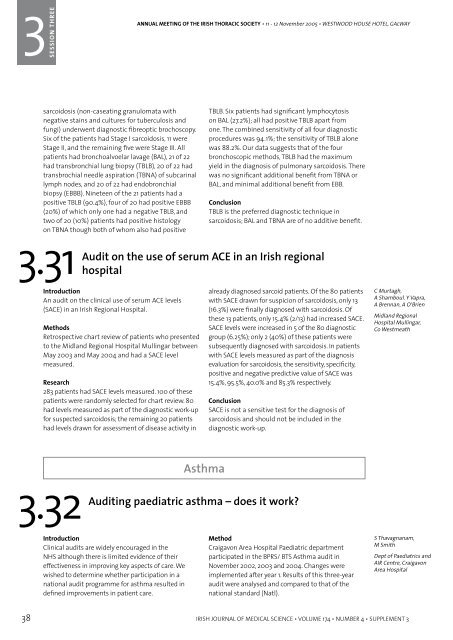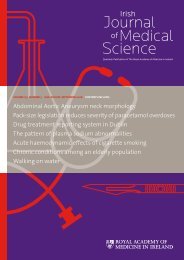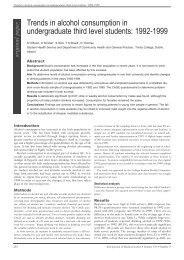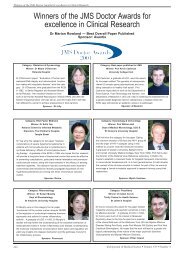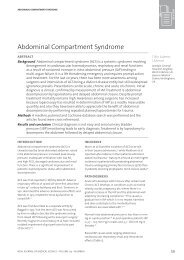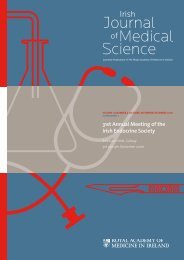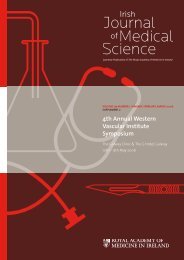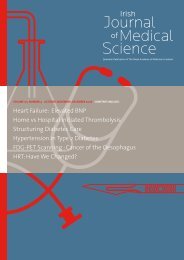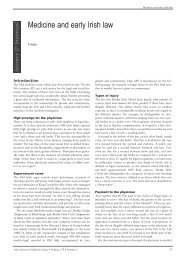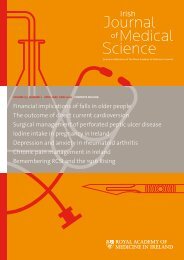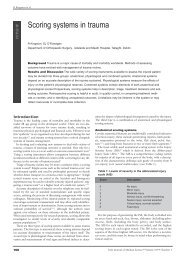Annual General Meeting of the Irish Thoracic Society - IJMS | Irish ...
Annual General Meeting of the Irish Thoracic Society - IJMS | Irish ...
Annual General Meeting of the Irish Thoracic Society - IJMS | Irish ...
You also want an ePaper? Increase the reach of your titles
YUMPU automatically turns print PDFs into web optimized ePapers that Google loves.
31<br />
1<br />
SESSION THREE ONE<br />
ANNUAL MEETING OF THE IRISH THORACIC SOCIETY • 11 - 12 November 2005 • WESTWOOD HOUSE HOTEL, GALWAY<br />
ANNUAL MEETING OF THE IRISH THORACIC SOCIETY • 11 - 12 November 2005 • WESTWOOD HOUSE HOTEL, GALWAY<br />
3<br />
SESSION<br />
SESSION THREE ONE<br />
sarcoidosis (non-caseating granulomata with<br />
negative stains and cultures for tuberculosis and<br />
fungi) underwent diagnostic fibreoptic brochoscopy.<br />
Six <strong>of</strong> <strong>the</strong> patients had Stage I sarcoidosis, 11 were<br />
Stage II, and <strong>the</strong> remaining five were Stage III. All<br />
patients had bronchoalvoelar lavage (BAL), 21 <strong>of</strong> 22<br />
had transbronchial lung biopsy (TBLB), 20 <strong>of</strong> 22 had<br />
transbrochial needle aspiration (TBNA) <strong>of</strong> subcarinal<br />
lymph nodes, and 20 <strong>of</strong> 22 had endobronchial<br />
biopsy (EBBB). Nineteen <strong>of</strong> <strong>the</strong> 21 patients had a<br />
positive TBLB (90.4%), four <strong>of</strong> 20 had positive EBBB<br />
(20%) <strong>of</strong> which only one had a negative TBLB, and<br />
two <strong>of</strong> 20 (10%) patients had positive histology<br />
on TBNA though both <strong>of</strong> whom also had positive<br />
3.31<br />
Audit on <strong>the</strong> use <strong>of</strong> serum ACE in an <strong>Irish</strong> regional<br />
hospital<br />
Introduction<br />
An audit on <strong>the</strong> clinical use <strong>of</strong> serum ACE levels<br />
(SACE) in an <strong>Irish</strong> Regional Hospital.<br />
Methods<br />
Retrospective chart review <strong>of</strong> patients who presented<br />
to <strong>the</strong> Midland Regional Hospital Mullingar between<br />
May 2003 and May 2004 and had a SACE level<br />
measured.<br />
Research<br />
283 patients had SACE levels measured. 100 <strong>of</strong> <strong>the</strong>se<br />
patients were randomly selected for chart review. 80<br />
had levels measured as part <strong>of</strong> <strong>the</strong> diagnostic work-up<br />
for suspected sarcoidosis; <strong>the</strong> remaining 20 patients<br />
had levels drawn for assessment <strong>of</strong> disease activity in<br />
3.32<br />
Asthma<br />
TBLB. Six patients had significant lymphocytosis<br />
on BAL (27.2%); all had positive TBLB apart from<br />
one. The combined sensitivity <strong>of</strong> all four diagnostic<br />
procedures was 94.1%; <strong>the</strong> sensitivity <strong>of</strong> TBLB alone<br />
was 88.2%. Our data suggests that <strong>of</strong> <strong>the</strong> four<br />
bronchoscopic methods, TBLB had <strong>the</strong> maximum<br />
yield in <strong>the</strong> diagnosis <strong>of</strong> pulmonary sarcoidosis. There<br />
was no significant additional benefit from TBNA or<br />
BAL, and minimal additional benefit from EBB.<br />
Conclusion<br />
TBLB is <strong>the</strong> preferred diagnostic technique in<br />
sarcoidosis; BAL and TBNA are <strong>of</strong> no additive benefit.<br />
already diagnosed sarcoid patients. Of <strong>the</strong> 80 patients<br />
with SACE drawn for suspicion <strong>of</strong> sarcoidosis, only 13<br />
(16.3%) were finally diagnosed with sarcoidosis. Of<br />
<strong>the</strong>se 13 patients, only 15.4% (2/13) had increased SACE.<br />
SACE levels were increased in 5 <strong>of</strong> <strong>the</strong> 80 diagnostic<br />
group (6.25%); only 2 (40%) <strong>of</strong> <strong>the</strong>se patients were<br />
subsequently diagnosed with sarcoidosis. In patients<br />
with SACE levels measured as part <strong>of</strong> <strong>the</strong> diagnosis<br />
evaluation for sarcoidosis, <strong>the</strong> sensitivity, specificity,<br />
positive and negative predictive value <strong>of</strong> SACE was<br />
15.4%, 95.5%, 40.0% and 85.3% respectively.<br />
Conclusion<br />
SACE is not a sensitive test for <strong>the</strong> diagnosis <strong>of</strong><br />
sarcoidosis and should not be included in <strong>the</strong><br />
diagnostic work-up.<br />
Auditing paediatric asthma – does it work?<br />
Introduction<br />
Clinical audits are widely encouraged in <strong>the</strong><br />
NHS although <strong>the</strong>re is limited evidence <strong>of</strong> <strong>the</strong>ir<br />
effectiveness in improving key aspects <strong>of</strong> care. We<br />
wished to determine whe<strong>the</strong>r participation in a<br />
national audit programme for asthma resulted in<br />
defined improvements in patient care.<br />
Method<br />
Craigavon Area Hospital Paediatric department<br />
participated in <strong>the</strong> BPRS/ BTS Asthma audit in<br />
November 2002, 2003 and 2004. Changes were<br />
implemented after year 1. Results <strong>of</strong> this three-year<br />
audit were analysed and compared to that <strong>of</strong> <strong>the</strong><br />
national standard (Natl).<br />
C Murtagh,<br />
A Shamboul. Y Vapra,<br />
A Brennan, A O’Brien<br />
Midland Regional<br />
Hospital Mullingar,<br />
Co Westmeath<br />
S Thavagnanam,<br />
M Smith<br />
Dept <strong>of</strong> Paediatrics and<br />
AIR Centre, Craigavon<br />
Area Hospital<br />
Results<br />
There were 11-16 patients with acute asthma admitted<br />
each November during <strong>the</strong> study periods (M: 74%,<br />
F: 26%). Ninety-seven per cent <strong>of</strong> patients received<br />
bronchodilators ei<strong>the</strong>r via spacer /nebuliser as first<br />
line (Natl =98%). Oral/IV steroids were given on an<br />
average <strong>of</strong> 88% (Natl=88%). There was an increase<br />
in <strong>the</strong> use <strong>of</strong> aminophylline (19% vs 4% Natl),<br />
antibiotics (30% vs 20% Natl) and Chest X-rays (59%<br />
vs 34% Natl). An increasing proportion <strong>of</strong> patients<br />
were given management plans (32% to 64%) and had<br />
3.33<br />
3.34<br />
Asthma admissions in children in Galway, trends over<br />
15 years<br />
Objective<br />
To study trends in admissions with acute asthma in<br />
children aged one to 14 years over <strong>the</strong> past 15 years.<br />
Setting<br />
Paediatric department in Regional hospital serving a<br />
child population <strong>of</strong> c.45,000.<br />
Methods<br />
Analysis <strong>of</strong> hospital in-patient enquiry system for<br />
children with a diagnosis <strong>of</strong> acute asthma 1990 -2004.<br />
Results<br />
Admissions increased steadily from 1990 to 1995, and<br />
<strong>the</strong>reafter halved over <strong>the</strong> next 10 years. This decline<br />
was most evident in <strong>the</strong> school age population (5-14<br />
years). Age specific admission rates were higher in<br />
<strong>the</strong> pre-school group throughout, and <strong>the</strong> though<br />
all rates have declined, that in one- to four-year-olds<br />
is still five times greater than in 5-14 year olds. The<br />
increase, and subsequent decrease in admissions<br />
was more evident in males.<br />
Conclusions<br />
Admission <strong>of</strong> children to hospital with acute asthma<br />
has declined in this area. This decline is most evident<br />
in school age children.<br />
An evaluation <strong>of</strong> nurse-led respiratory service in <strong>the</strong> 21st<br />
century: can clinical nurse specialists make a difference?<br />
Introduction<br />
The work <strong>of</strong> a respiratory clinical nurse specialist<br />
(CNS) has a significant impact on changing outcomes<br />
and improving quality <strong>of</strong> patient care. Continuity<br />
<strong>of</strong> care has been a problem with COPD and asthma<br />
patients with care frequently delegated to junior non<br />
consultant hospital doctors (NCHD). In St Michael’s<br />
Hospital we have provided a respiratory nurse led<br />
service since October 2004. We assessed <strong>the</strong> patient’s<br />
perception <strong>of</strong> <strong>the</strong> benefits <strong>of</strong> this nurse led service.<br />
Methods<br />
The CNS has seen 60 patients since commencement <strong>of</strong><br />
this service. Subjects (n= 25) were recruited to answer<br />
a postal questionnaire consisting <strong>of</strong> 12 questions.<br />
The questions were divided into five different areas:<br />
history, diagnosis, existing knowledge <strong>of</strong> condition,<br />
evaluation <strong>of</strong> service and additional comments.<br />
device technique assessed (50% to 64%). There was<br />
no change in frequency <strong>of</strong> information leaflets given<br />
(50% to 45%).<br />
Conclusions<br />
Participation and implementation <strong>of</strong> change based on<br />
<strong>the</strong> national asthma audit programme has resulted<br />
in an increase in evidence-based care however it has<br />
also highlighted deficiencies in certain areas. Effective<br />
implementation <strong>of</strong> change needs to involve all<br />
stakeholders and involve multi-layer interventions.<br />
Results<br />
The response rate to <strong>the</strong> questionnaire showed that<br />
94% were satisfied with <strong>the</strong> nurse led service however,<br />
6% expressed a concern <strong>the</strong>re was inadequate<br />
explanation provided regarding <strong>the</strong>ir condition.<br />
Continuity <strong>of</strong> care is demonstrated by <strong>the</strong> fact that<br />
33% <strong>of</strong> <strong>the</strong> patients returned twice and 8% returned<br />
three times.<br />
Conclusion<br />
The results support <strong>the</strong> use <strong>of</strong> a respiratory nurse led<br />
service. This has demonstrated continuity <strong>of</strong> care and<br />
no patient has expressed a desire to relocate to <strong>the</strong><br />
conventional doctor led clinic. This clinic is an example<br />
<strong>of</strong> how a nurse led respiratory service is progressing<br />
towards advanced nurse practitioner status.<br />
A Shabu, E Crushell,<br />
BG L<strong>of</strong>tus<br />
Dept <strong>of</strong> Paediatrics,<br />
NUI, Galway<br />
MF O’Driscoll, 1<br />
MM Nagle, 1<br />
TJ Mc Donnell 2<br />
1. Dept <strong>of</strong> Nursing, and<br />
2. Respiratory<br />
Medicine<br />
St Michael’s<br />
Hospital,<br />
Dun Laoghaire,<br />
Co. Dublin<br />
38 IRISH JOURNAL OF MEDICAL SCIENCE • VOLUME 174 • NUMBER 4 • SUPPLEMENT 3<br />
IRISH JOURNAL OF MEDICAL SCIENCE • VOLUME 174 • NUMBER 4 • SUPPLEMENT 3 39


